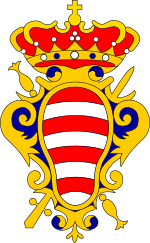Coat of arms of Dubrovnik
| Coat of arms of the Republic of Ragusa Coat of arms of Dubrovnik |
|
|---|---|
 |
|
| Versions | |

Alternative version (inaccurate), originating as a misinterpretation.
|
|
| Details |
The Coat of arms of the Republic of Ragusa was the heraldic symbol of the historical Republic of Ragusa. It is today used in a variant for the city of Dubrovnik, Croatia. Its basic appearance is based on the coat of arms of the Árpád dynasty.
During the intermittent administration of Dubrovnik by Byzantine Empire, which lasted until 1205, the use of heraldic symbols such as coat of arms was not in practice. The city used Byzantine imperial flags until 1171. When Dubrovnik passed to the Republic of Venice the official symbol became the Lion of Saint Mark. With the end of the Venetian rule all the symbols of the previous government were removed, with only one stone tablet remaining showing the Venetian lion.
With the Treaty of Zadar the Republic of Venice relinquished its claims on the eastern coast of the Adriatic in favour of Louis I and the Venetians left Dubrovnik for good. With the Treaty of Visegrád in 1358, between Dubrovnik and Louis I., they have committed to use his flag or coat of arms which contained the mentioned arms of Árpád dynasty (red and white bars). In 1359 they ordered flags to be made from Venice containing the arms of Kingdom of Hungary and in 1362 they also ordered flags with Saint Blaise. According to some sources the use of the Hungarian arms depended on various foreign policy conditions and so the government of the Republic of Ragusa issued an order to all ship captains that they should not assert any other symbols except those of the Republic (with Saint Blaise) and those of the Hungarian kingdom.
In Dubrovnik the coat of arms with the red and white bars became widely accepted as the arms of the Republic and as such the Republic kept its use even after the Republic of Ragusa became independent from the affairs of the Kingdom of Hungary. Although it was recognized as a sign of submission to the King, the arms were now generally accepted as a sign of sovereignty of the Dubrovnik Republic.
...
Wikipedia
